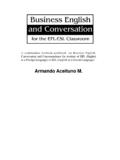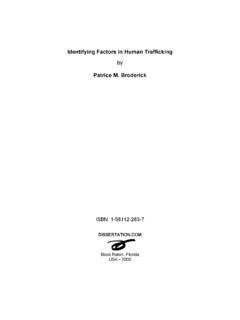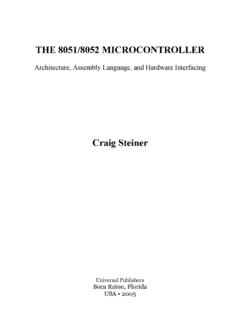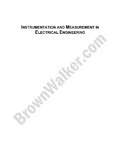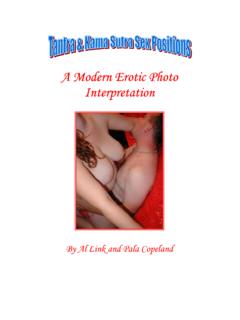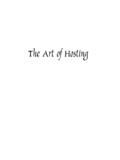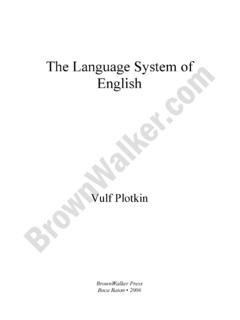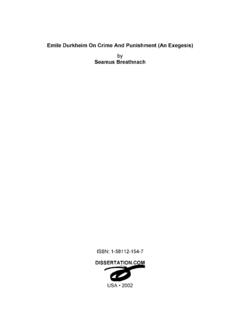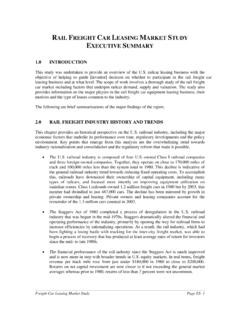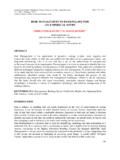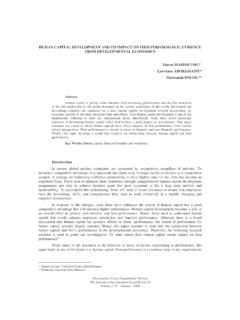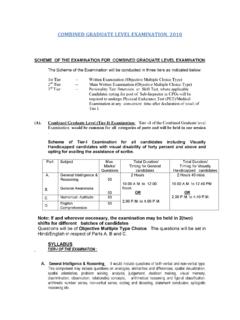Transcription of AN INVESTIGATION OF COMMODITY THEORY AND ITS …
1 AN INVESTIGATION OF COMMODITY THEORY . AND ITS APPLICATION TO CRITICAL MEDIA STUDIES. by Jeffrey R. Young ISBN: 0-9658564-0-2. 1997.. AN INVESTIGATION OF COMMODITY THEORY . AND ITS APPLICATION TO CRITICAL MEDIA STUDIES. by Jeffrey R. Young A Thesis Submitted to the Faculty of The Schmidt College of Arts and Humanities in Partial Fulfillment of the Requirements for the Degree of Master of Arts Florida Atlantic University Boca Raton, Florida April 1996. Copyright 1996 by Jeffrey R. Young ii AN INVESTIGATION OF COMMODITY THEORY . AND ITS APPLICATION TO CRITICAL MEDIA STUDIES. by Jeffrey R. Young This thesis was prepared under the direction of the candidate's thesis advisor, Dr. Mike Budd, Department of Communication, and has been approved by the members of his supervisory committee. It was submitted to the faculty of The Schmidt College of Arts and Humanities and was accepted in partial fulfillment of the requirements for the degree of Master of Arts in Communication. iii ABSTRACT. Author: Jeffrey R.
2 Young Title: An INVESTIGATION of COMMODITY THEORY and its Application to Critical Media Studies Institution: Florida Atlantic University Advisor: Dr. Mike Budd Degree: Master of Arts Year: 1996. The THEORY of the COMMODITY is used by critical theo- rists to explain the general organization and development of capitalist society. It was originally proposed by Marx, and subsequently developed by Luk cs and later Adorno and the Frankfurt School. Media scholars such as Dallas Smythe, Judith Williamson, Robert Goldman and Eileen Meehan have identified the COMMODITY structure in several forms through- out the process of mass communication. Although COMMODITY THEORY is not always articulated as a part of critical studies, it is useful for understanding the process of mass communication under capitalism. By investigating the dynam- ics of market processes and cultural innovation, this paper shows where the THEORY of the COMMODITY fits into Critical Media Studies and suggests where some productive applica- tions may be found.
3 Iv TABLE OF CONTENTS. Chapter Page I. INTRODUCTION .. 1. II. THE INTELLECTUAL GENESIS AND DEVELOPMENT. OF COMMODITY THEORY .. 8. Use Value and Exchange Value Estranged Labor The Fetishism of Commodities Georg Luk cs and Social Reification Theodor Adorno and the Frankfurt School III. APPLICATIONS OF COMMODITY THEORY . TO CRITICAL MEDIA STUDIES .. 39. The Infrastructure of the Media Commercial Advertising The Semiotics of Advertising A Model of the COMMODITY Structure in the Media IV. THE TENSION BETWEEN. ECONOMIC COMMODITIES AND CULTURAL PRODUCTS .. 68. Contemporary Effects of Economic Commodification The Extremes of Commodification The Dynamics of Market Processes and Cultural Innovation V. SOME BENEFITS & LIMITATIONS OF COMMODITY THEORY . 84. The Economic Approach to Social THEORY A Model for Using COMMODITY THEORY VI. CONCLUSION ..101. SELECTED BIBLIOGRAPHY ..106. Chapter I. INTRODUCTION. The purpose of this research project is to identify, articulate and extend the THEORY regarding the mass media's role in the social and economic process of commodification so it can be used more productively as a tool for critical media analysis.
4 It proceeds by organizing and analyzing the body of literature centered around the core of Karl Marx's formulation of COMMODITY THEORY , known as " COMMODITY fetish- ism." This THEORY which Marx originally employed to explain and analyze capitalist economic relations of production has since been developed and used by critical social theorists to address the social and cultural effects of mass communi- cation. Unlike "administrative" communication studies, Critical Studies diverges from the traditional undergraduate Communi- cation curriculum designed to prepare individuals to work in the communication industry as employees of media companies. Rather than studying communication phenomena to improve its 1. efficiency and persuasiveness, the focus of Critical Media Studies is to produce constructive criticism of the media establishment in an effort to improve its structure and policies. Consequently, Critical Media Studies diverges from administrative studies, not necessarily in its subject, but in its purpose.
5 COMMODITY THEORY provides a framework for approaching Critical Media Studies. It posits an explanation for the basic social motivations of 20th century capitalism. It is more than just an economic explanation of society; it is a framework for understanding social exchange from a variety of different perspectives under capitalism. COMMODITY relations are a significant element of social control in capitalist society, and the power of the media as a means of entertaining and informing people promotes these relations. The mass media are recognized by large corpora- tions and national governments as an effective means of social and political control. "In a fundamental sense, control over the means of informing people is the basis for political power."1 The aim of Critical Media Studies is to find the structures and mechanisms of the mass media that affect the values and behavior of society. This involves recognizing that the media institution involves a material 1. Dallas Smythe, "A Marxist THEORY of Communications, "Counterclockwise: Perspectives on Communication, ed.
6 Thomas Guback (Boulder, CO: Westview Press, 1994), p. 254. 2. infrastructure, an economic system of organization and a specially adapted apparatus for symbolic presentation. Consequently, it is shaped by material, economic and cultur- al forces. Critical Media Studies has traditionally been ap- proached from two perspectives: political economy and Cultural Studies. Each perspective reflects the academic tradition from which it evolved. Political economy is pre- dominantly explanatory, proceeding from the general THEORY to the particular phenomena in the tradition of the social sciences from which it developed. Scholars trained in polit- ical economy tend to explain the media through the macro-in- stitutional structure, class, and historical In contrast, Cultural Studies tends to be descriptive in na- ture. It proceeding from the particular to the general in the academic tradition of the humanities and qualitative social sciences from which it evolved. This approach seeks to describe and interpret the meaning of cultural practices and artifacts and the conditions surrounding the consumption of media messages.
7 2. Robert Babe, "Communication: Blindspot of Western Economics," in Illuminating the Blindspots: Essays Honoring Dallas W. Smythe, eds. Janet Wasko, Vincent Mosco, Manjunath Pendakur (Norwood, New Jersey: Ablex Publishing Corp., 1994), p. 17. 3. Despite the differences in approach, scholars who are involved in Critical Media Studies are united around discovering "the nature, sources, uses, and consequences of power."3 Most scholars would agree that no single theoreti- cal model can account for the diversity and contradictions of economic and cultural practice in the mass media. They would also agree that although capitalism perpetuates many undesirable social values, media products always contain excess meaning beyond the intentions of their producers. Consequently, media products may be both exploitative and domineering, while providing pleasure and This study incorporates both the macro-dynamic and a micro-dynamic perspective of social analysis; investigating both the political and institutional process of commodifica- tion, the semiotic construction of messages, and the struc- tures of meaning associated with commodification.
8 By ex- plaining the THEORY of the COMMODITY , investigating how media analysts have used it, organizing, comparing and contrasting with it with perspectives on COMMODITY THEORY from other disciplines, the author hopes to position commod- ity THEORY within the academic discourse of Critical Media 3. Ibid., p. 16. 4. Lawrence Grossberg, "Cultural Studies Vs. Political Economy: Is Anyone Else Bored with this Debate?" Critical Studies in Mass Communication 12 (March 1995): 76. 4. Studies, articulate its benefits and limitations, and sug- gest some productive areas for future research. The following two chapters present the primary litera- ture concerning the historical development and application of COMMODITY THEORY within Critical Media Studies. First, COMMODITY THEORY is presented as it was conceived by Marx and follows its development through World War II, just before the predominant influence of the mass media as a major social institution. Its development is explained as it progressed from Marx to Luk cs to Adorno and the Frankfurt School.
9 Next, chapter three describes how contemporary media analysts have applied COMMODITY THEORY to media analysis from the two basic approaches to Critical Media Studies. This section represents the direct application of COMMODITY THEORY to media studies and discusses the theoretical as- pects relevant to its understanding and use. Chapter four is an attempt to enlarge the scope of COMMODITY THEORY by investigating the tension between economic commodities and cultural artifacts. The purpose of this chapter is to inves- tigate possible applications of COMMODITY THEORY outside of Media Studies to get a better understanding of how it might be applied within the discipline. The final chapter con- trasts and synthesizes the two primary approaches to Criti- cal Media Studies around COMMODITY THEORY in order to sug- 5. gest where the benefits and limitations of its use may be found. Here, the author introduces a general model for estimating the productivity of COMMODITY THEORY to communi- cation research.
10 As a tool, this model suggests what kinds of problems and in what areas of study one can expect com- modity THEORY to be most useful. The chapters are arranged to present COMMODITY THEORY as it developed chronologically as well as a structurally. This arrangement is considered appropriate since the genesis of COMMODITY THEORY occurred before the predominance of the mass media. Although, excellent work and reviews5 are avail- able that rely on COMMODITY THEORY to support key assump- tions, most contemporary discussions do not review the development or justification for COMMODITY THEORY . The noted studies by Leiss, Kline, Jhally, Ewen and Miller were the inspiration for this paper. These works reveal to the stu- dent of communication many of the irrational forces of capitalism on the mass media. Under the guidance of the author's thesis advisor, the author proceeded to investigate the theoretical aspects of the THEORY as it developed from 5. John Harms and Douglas Kellner, "Critical THEORY and Advertising," Current Perspectives in Social THEORY , ed.
